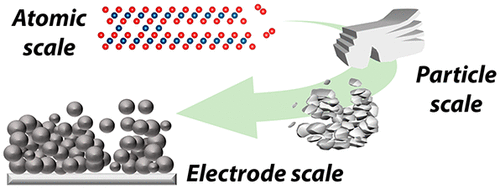当前位置:
X-MOL 学术
›
Acc. Mater. Res.
›
论文详情
Our official English website, www.x-mol.net, welcomes your feedback! (Note: you will need to create a separate account there.)
Characterizing and Mitigating Chemomechanical Degradation in High-Energy Lithium-Ion Battery Cathode Materials
Accounts of Materials Research ( IF 14.6 ) Pub Date : 2022-02-25 , DOI: 10.1021/accountsmr.1c00282 Norman S. Luu 1 , Kyu-Young Park 1 , Mark C. Hersam 1, 2, 3
Accounts of Materials Research ( IF 14.6 ) Pub Date : 2022-02-25 , DOI: 10.1021/accountsmr.1c00282 Norman S. Luu 1 , Kyu-Young Park 1 , Mark C. Hersam 1, 2, 3
Affiliation

|
Lithium-ion batteries (LIBs) are nearly ubiquitous energy storage solutions, powering devices ranging from consumer electronics to electric vehicles. To advance these applications, current LIB research efforts are directed toward improving energy and power densities, cyclic lifetimes, charging speeds, and safety. These parameters are intrinsically tied to properties of the active electrode materials, such as the redox mechanism, chemical composition, and crystal structure. One particularly challenging issue is that the active electrode materials that possess higher theoretical energy densities are generally more susceptible to degradation during cycling. A notable example is the family of layered multicomponent transition metal oxides, which is the incumbent class of active LIB cathode materials for electric vehicles. To increase their theoretical capacities, the transition metal fraction in these materials is trending toward higher Ni content. However, Ni-rich chemistries suffer from electrochemical, crystallographic, and mechanical degradation that increase in severity with increasing Ni content. Furthermore, alternative high-energy cathode materials, including overlithiated layered oxides and disordered rock salt materials, present additional stability challenges that must be overcome before they can be realistically incorporated into LIB technology.
中文翻译:

表征和减轻高能锂离子电池正极材料的化学机械降解
锂离子电池 (LIB) 几乎是无处不在的储能解决方案,可为从消费电子产品到电动汽车的各种设备供电。为了推进这些应用,当前的 LIB 研究工作致力于提高能量和功率密度、循环寿命、充电速度和安全性。这些参数本质上与活性电极材料的性质有关,例如氧化还原机理、化学成分和晶体结构。一个特别具有挑战性的问题是,具有较高理论能量密度的活性电极材料通常在循环过程中更容易降解。一个值得注意的例子是层状多组分过渡金属氧化物家族,它是电动汽车中现有的一类活性锂离子电池正极材料。为了提高它们的理论容量,这些材料中的过渡金属部分趋向于更高的镍含量。然而,富含 Ni 的化学物质会遭受电化学、晶体学和机械降解的影响,随着 Ni 含量的增加,这些降解的严重性也会增加。此外,替代的高能正极材料,包括过锂化层状氧化物和无序岩盐材料,提出了额外的稳定性挑战,必须先克服这些挑战,然后才能将它们实际纳入 LIB 技术。
更新日期:2022-02-25
中文翻译:

表征和减轻高能锂离子电池正极材料的化学机械降解
锂离子电池 (LIB) 几乎是无处不在的储能解决方案,可为从消费电子产品到电动汽车的各种设备供电。为了推进这些应用,当前的 LIB 研究工作致力于提高能量和功率密度、循环寿命、充电速度和安全性。这些参数本质上与活性电极材料的性质有关,例如氧化还原机理、化学成分和晶体结构。一个特别具有挑战性的问题是,具有较高理论能量密度的活性电极材料通常在循环过程中更容易降解。一个值得注意的例子是层状多组分过渡金属氧化物家族,它是电动汽车中现有的一类活性锂离子电池正极材料。为了提高它们的理论容量,这些材料中的过渡金属部分趋向于更高的镍含量。然而,富含 Ni 的化学物质会遭受电化学、晶体学和机械降解的影响,随着 Ni 含量的增加,这些降解的严重性也会增加。此外,替代的高能正极材料,包括过锂化层状氧化物和无序岩盐材料,提出了额外的稳定性挑战,必须先克服这些挑战,然后才能将它们实际纳入 LIB 技术。



























 京公网安备 11010802027423号
京公网安备 11010802027423号